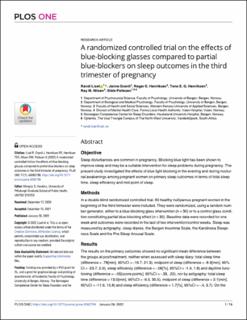| dc.description.abstract | Objective
Sleep disturbances are common in pregnancy. Blocking blue light has been shown to improve sleep and may be a suitable intervention for sleep problems during pregnancy. The present study investigated the effects of blue light blocking in the evening and during nocturnal awakenings among pregnant women on primary sleep outcomes in terms of total sleep time, sleep efficiency and mid-point of sleep.
Methods
In a double-blind randomized controlled trial, 60 healthy nulliparous pregnant women in the beginning of the third trimester were included. They were randomized, using a random number generator, either to a blue-blocking glass intervention (n = 30) or to a control glass condition constituting partial blue-blocking effect (n = 30). Baseline data were recorded for one week and outcomes were recorded in the last of two intervention/control weeks. Sleep was measured by actigraphy, sleep diaries, the Bergen Insomnia Scale, the Karolinska Sleepiness Scale and the Pre-Sleep Arousal Scale.
Results
The results on the primary outcomes showed no significant mean difference between the groups at posttreatment, neither when assessed with sleep diary; total sleep time (difference = .78[min], 95%CI = -19.7, 21.3), midpoint of sleep (difference = -8.9[min], 95%CI = -23.7, 5.9), sleep efficiency (difference = -.06[%], 95%CI = -1.9, 1.8) and daytime functioning (difference = -.05[score points], 95%CI = -.33, .22), nor by actigraphy; total sleep time (difference = 13.0[min], 95%CI = -9.5, 35.5), midpoint of sleep (difference = 2.1[min], 95%CI = -11.6, 15.8) and sleep efficiency (difference = 1.7[%], 95%CI = -.4, 3.7). On the secondary outcomes, the Bergen Insomnia Scale, the Karolinska Sleepiness Scale and the Pre-Sleep Arousal Scale the blue-blocking glasses no statistically significant difference between the groups were found. Transient side-effects were reported in both groups (n = 3).
Conclusions
The use of blue-blocking glasses compared to partially blue-blocking glasses in a group of healthy pregnant participants did not show statistically significant effects on sleep outcomes. Research on the effects of blue-blocking glasses for pregnant women with sleep-problems or circadian disturbances is warranted. | en_US |

